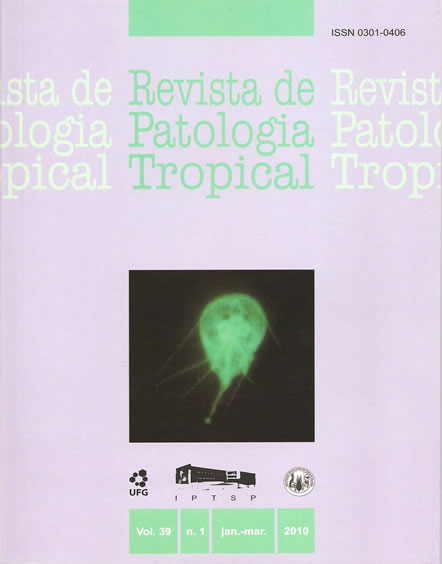Giardia lamblia: distribution of microtubules on the cytoskeleton of trophozoites and cysts by use of fluorescent taxoid
DOI:
https://doi.org/10.5216/rpt.v39i1.9495Keywords:
FLUTAX-2, Giardia lamblia, Microtubule, Taxol.Abstract
G. lamblia is a protozoan parasite of the small intestine and the etiologic agent ofgiardiosis, which presents a complex cytoskeleton composed of microtubules. In
this study, the microtubule cytoskeleton was labeled in trophozoites and cysts of
G. lamblia, using a fluorescent taxoid (FLUTAX-2), a derivative of Taxol, which
binds to ??-tubulin dimer polymerized. In addition, the effect of metronidazole on
the cytoskeleton of the parasite was also evaluated. FLUTAX-2 was able to label
the microtubules of trophozoites and cysts, allowing the observation of cytoskeletal
structures, such as flagella, funis, adhesive disk, and median body. Moreover,
FLUTAX-2 labeled the trophozoites from several different cultivation times,
revealing the 48 hours as the best incubation period. The incubation of parasites in
presence of metronidazole did not show significant alteration on the microtubule
labeling by FLUTAX-2. We have shown the FLUTAX-2 labeling in other protozoa,
Trichomonas vaginalis, T. gallinae and Tritrichomonas foetus, and this is the first
report revealing the binding profile in G. lamblia. Our results contribute to the
knowledge of biological and morphological features of this intestinal pathogen. Furthermore, our data showed no modification of microtubule profile labeling in
presence of metronidazole. Finally, a new perspective for giardiosis diagnostic
is suggested, since trophozoites and cysts of G. lamblia were labeled with FLUTAX-2.
Downloads
Downloads
Published
How to Cite
Issue
Section
License
The manuscript submission must be accompanied by a letter signed by all authors stating the full name and email address, confirming that the material has not been published or is under consideration for publication elsewhere, and agreeing to transfer copyright in all media and formats for Journal of Tropical Pathology. The authors will not be paid for published articles. They are solely responsible for the content of those articles, even if the Editor holds the right to adjust them to the norms of the journal.
The reviewers will not be paid for the peer review process.

